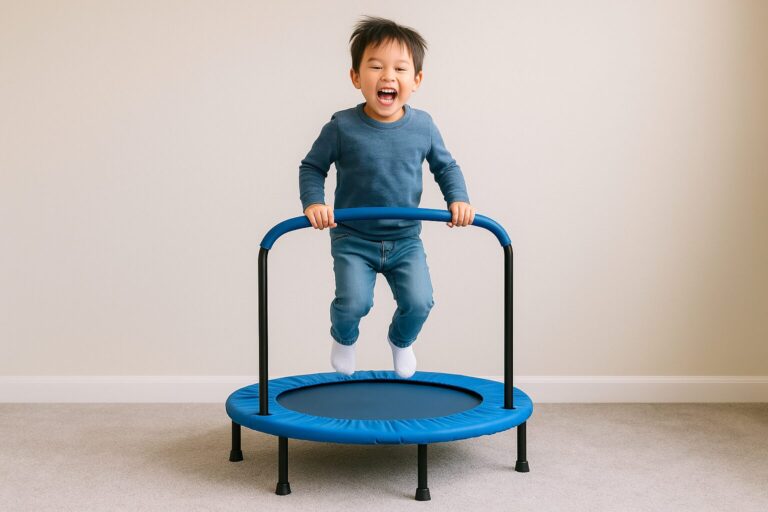Trampolines are one of the most effective sensory tools for children with autism who seek movement or struggle with emotional regulation. Jumping provides deep proprioceptive and vestibular input, which helps with focus, body awareness, and calming energy. Whether for indoor play or therapy routines, sensory trampolines are powerful tools for both fun and function.
🔍 Why Trampolines Work for Sensory Needs
- Proprioceptive input: Repetitive jumping delivers joint and muscle stimulation that helps with calming and focus.
- Vestibular feedback: The up-and-down motion supports balance, coordination, and spatial awareness.
- Emotional regulation: Trampoline breaks help manage meltdowns and release built-up energy safely.
- Builds core strength: Encourages movement without overstimulation or pressure.
👩⚕️ Therapist-Approved for Home & School
- Occupational therapists often use mini trampolines during sessions to engage attention and regulate the nervous system.
- Parents find that short trampoline sessions before transitions (e.g., school, meals, bedtime) help ease anxiety and improve cooperation.
🛒 Top 3 Sensory Trampolines for Autistic Children
⭐ 36″ Foldable Indoor Mini Trampoline with Handle
Best for: Indoor use and daily movement breaks
This compact trampoline includes a stability handle and folds for easy storage. It’s perfect for living rooms or bedrooms and supports safe, repetitive jumping without overwhelming space.
Parent tip: Use in 5-minute sessions as a sensory break throughout the day.
🌈 Trampoline with Padded Enclosure (Safety Net)
Best for: Younger children needing enclosed play
This trampoline includes a safety enclosure and padded frame for worry-free movement. It offers both safety and freedom—ideal for kids who crave movement but need extra structure.
Parent tip: Add soft sensory balls or bean bags inside for playful resistance.
🛋️ Mini Rebounder Trampoline (Therapy-Grade)
Best for: Home therapy or calming sensory routines
Designed for quiet, low-impact bouncing, this rebounder supports body awareness and regulation without high stimulation. A great addition to any sensory room or homeschool space.
Parent tip: Pair with music or a visual timer for structured sensory breaks.
🎯 How to Use Trampolines for Sensory Regulation
- Use for 3–10 minutes depending on age and energy level
- Incorporate into daily sensory routines—morning, after school, or before transitions
- Allow your child to lead the play (bounce rhythm, duration)
- Always supervise to ensure safety
🧠 Activity Ideas with Sensory Trampolines
- Jump Counting Game: Count jumps aloud to build language and motor control.
- Freeze Bounce: Add music and pause it randomly to practice impulse control.
- Sensory Jump Circuit: Combine trampoline time with other sensory stations like wall pushups or beanbag toss.
🙋♀️ Frequently Asked Questions
Are trampolines safe for autistic children?
Yes—with supervision and age-appropriate designs. Look for models with handles or enclosures and always use on flat, soft surfaces.
How long should my child use a trampoline?
Start with 3–5 minutes and gradually extend as part of a structured sensory break or movement routine.
What type of trampoline is best for sensory needs?
Small indoor trampolines with a handle or enclosed safety net work best for younger children. For therapy use, rebounders are ideal.
As an Amazon Associate, SensoryGift.com earns from qualifying purchases. Thanks for helping us bring sensory support to more families.


